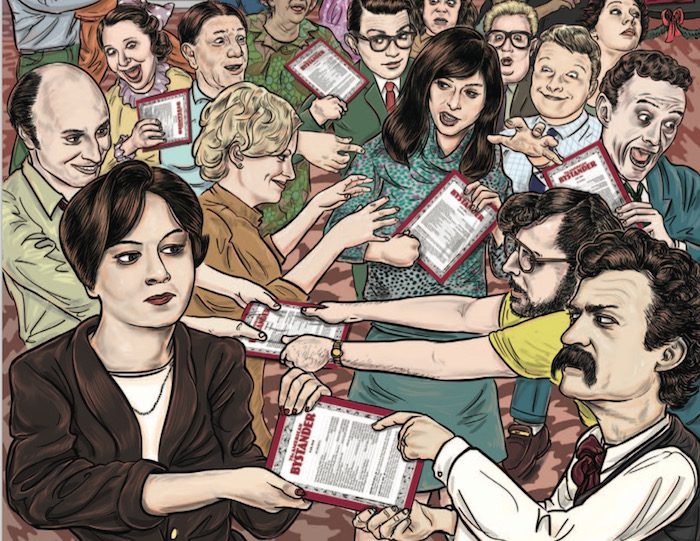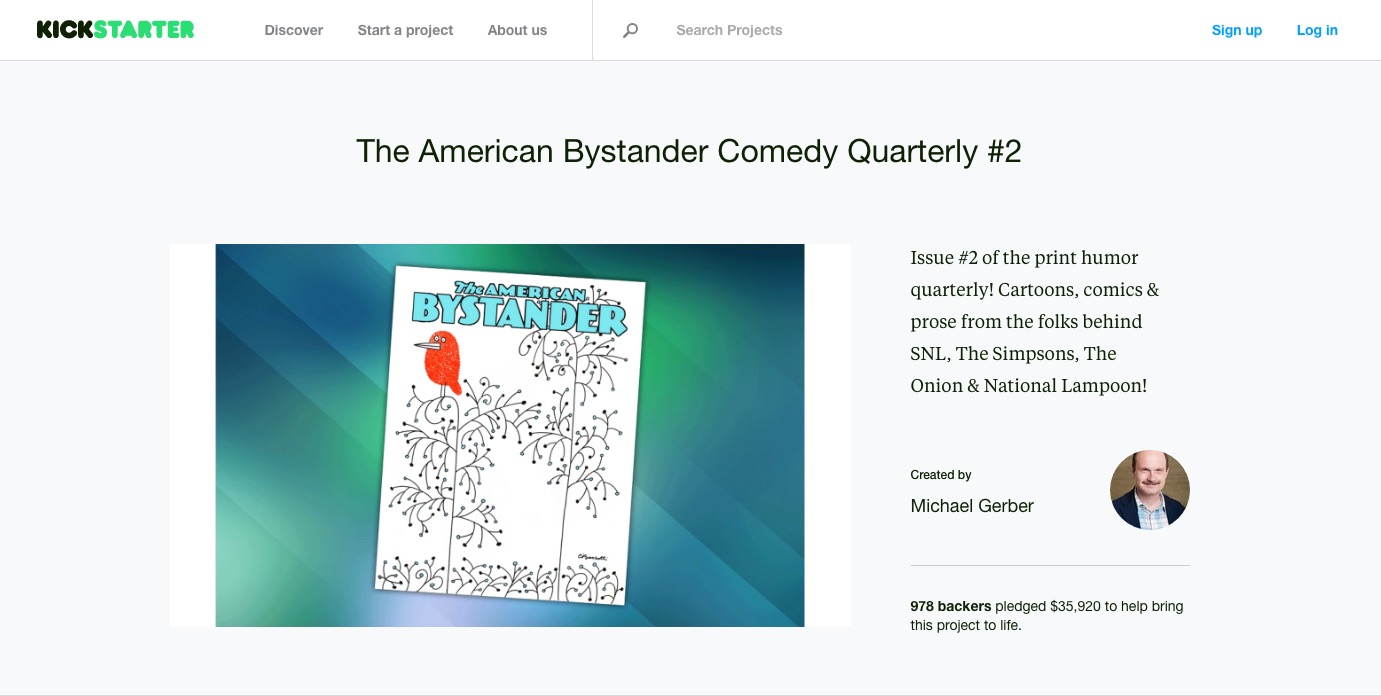
On April 21, 1983, the comedy writer Brian McConnachie appeared on Late Night with David Letterman to promote The American Bystander, the comedy magazine he was trying to launch.
“It’s a gathering of talent,” McConnachie, a former Saturday Night Live and National Lampoon writer, told Letterman. And in a 1982 interview with The New York Times, McConnachie said, “Magazines are one of the last places that can risk failure. Noble failures, where you see all the rough edges, are terrific. You learn more from noble failures than you do from slick successes.”
The American Bystander was a failure — it folded after, uh, one issue — but more than thirty years later, McConnachie has helped launch a new version of the Bystander that’s trying to bring back the print humor magazine.
The first issue of the revived American Bystander came out last fall and a second issue is set to be published this spring. It features cartoons and articles, such as “Atlas Slugged Again: Annyn Rant’s Long-Lost ‘Secret Sequel’ to Atlas Slugged” and “A Brief History of Sandwich Theory.” Contributors to the magazine have written for The Simpsons, Saturday Night Live, Monty Python, and other beloved comedy properties. (Some names you might recognize: George Meyer, Jack Handey, Terry Jones, Roz Chast, Kate Beaton, Edward Sorel, and Mallory Ortberg.)

Even before the Internet ravaged the business model for print media, it wasn’t easy for humor magazines to make a go of it. The Onion just stopped publishing in print in 2013, but The National Lampoon and Spy both ceased publication in 1998. The Realist died in 2001. And although it still comes out a few times a year, Mad magazine doesn’t have the cultural cachet that it had at its height.
The American Bystander is an attempt to recreate what many of those publications attempted editorially, but it’s developing a primarily reader-supported model that eschews an online presence (its website and social accounts are just used to sell copies of the magazine and promote its Kickstarter campaigns) in favor of a hefty, book-like publication, aimed at readers who grew up reading humor magazines or simply cherish that type of humor writing.
“Old fans of National Lampoon and magazines like that, old fans of Spy — both of those were constituencies that were in the millions and hundreds of thousands, which haven’t really been served since 1998 by a print vehicle,” said Michael Gerber, the Bystander’s publisher, perhaps best known for the Harry Potter spoof Barry Trotter and the Unauthorized Parody. “The Onion does one portion of what the Lampoon and Spy used to do, but it’s been 20 years since those [fans] have had anything that they could really grab.”
The first two issues of American Bystander were funded through individual Kickstarter campaigns; the team turned to crowdfunding to gauge demand and determine whether there is a feasible way to turn the magazine into a subscription product.
The campaign for the first issue attracted 853 backers and surpassed its $25,000 goal, raising $41,802. The resulting issue was 146 pages long, with about 2,000 copies mailed out. Readers can also purchase copies through Amazon or Barnes & Noble, and some brick-and-mortar bookstores. (Kickstarter backers can also get a PDF version of the magazine.)

The second issue of the magazine has 978 Kickstarter backers who again beat the $25,000 goal, chipping in $35,920. Gerber said he expects that the second issue will be about 20 percent longer than the first, and it’s scheduled to start shipping in late May.
Though there’s been some demand from readers for a subscription offering, the Bystander wants to be cautious in growing its business. Gerber described himself as “risk-averse” and said he wants to ensure that the magazine would be able to deliver at least four quarterly issues to subscribers.
“Subscriptions are a promise that you’re going to make the issues,” Gerber said, and to fulfill that promise, the Bystander needs about $100,000 in the bank. That would require around 3,000 subscribers at minimum, he said.
“What we’re doing now is gathering the tribe,” he said. “We don’t know how big that tribe is. I set it up so that it will work with 3,000 paid readers and will thrive at 5,000. If we can get 20,000, we’ll be doing great. But I don’t know. We could top out with this issue.”
The Bystander isn’t the only publication trying to make the most of a dedicated niche audience that’s willing to pay for its product. Other established outlets such as ProPublica, The Texas Tribune, and PRX have all used Kickstarter to fund projects.Creating a print publication comes with different challenges and costs than creating a digital one — paying to print and distribute the magazine, for starters — but others also have used Kickstarter to launch print products. The most funded journalism project ever on Kickstarter is Kazoo, a print magazine for girls. In a campaign that ended Tuesday, Kazoo raised nearly $170,000 from about 3,100 backers. The soccer magazine Howler also launched with a $69,001 Kickstarter campaign in 2012. Its tenth issue came out this spring.
This reader-focused strategy isn’t new, but it’s taken on a renewed urgency in recent weeks as many have begun to question whether there’s a limit to the ad-supported business model that’s dependent on massive reach. The Financial Times reported that BuzzFeed had missed its 2015 financial targets and cut its forecasts for 2016. (BuzzFeed denied the details of the report.) Mashable also eliminated 30 positions this month.In the Bystander, advertising is limited. It will provide display ad space for books and albums produced by its contributors or for other products it thinks its readership might like. (An example: An ad for Mallory Ortberg’s book Texts from Jane Eyre ran opposite the piece she contributed to the magazine.)
Readers who backed the product on Kickstarter can also place classified ads in the back of the magazine. And, this being a humor magazine, the Bystander runs ads for fake products next to the real ones. “If you run fake ads and real ads at once, people will look at the ads very closely because they try to figure out which is which,” Gerber said.
 The Bystander’s approach to advertising was deliberate because the magazine didn’t want to have to compromise its humor to please advertisers.
The Bystander’s approach to advertising was deliberate because the magazine didn’t want to have to compromise its humor to please advertisers.
“I don’t want to structure this financially to depend on advertisers,” Gerber said. “Once you do that, you are serving the advertisers, not the reader.”
All Bystander contributors are paid.
If the Bystander doesn’t meet subscription targets, Gerber said it would consider other funding models or scale back to publishing just once a year. The ultimate goal is to create a sustainable magazine that’s able to support its creators and provide new and veteran comedy writers a place to publish their work.
“My goal with this is to put money in the pockets of writers and artists, and that includes us,” he said. “If the audience is big enough, I want to be able to serve that audience. I live in the world, just like everybody, and I have to pay my rent, just like everybody, but the commitment to this from everybody is pretty pure. We love the stuff, we want to do it, and we think there should be a place for it in the world.”